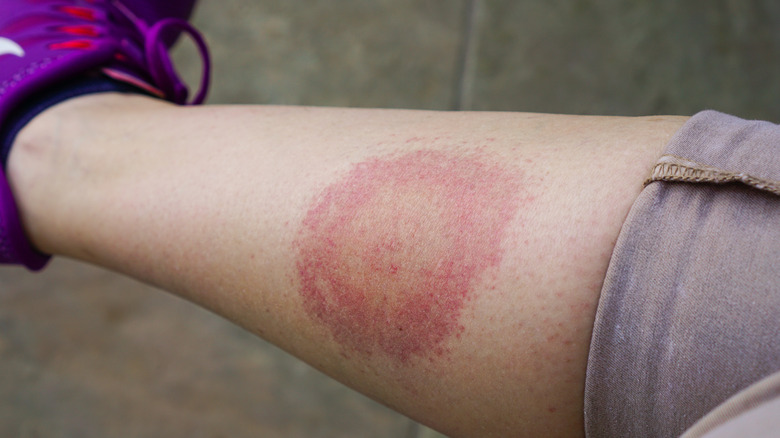What It Really Means When You Get A Bull's-Eye Rash
A bull's-eye rash, clinically known as an erythema migrans, is a classic early symptom of Lyme disease (via Healthline). It may first appear as a circular spot on the skin near the site of a tick bite, and can eventually include a ring around it, making a "bull's eye" shape. While this isn't the only sign of Lyme disease, it is a very common one, according to the American Academy of Dermatology Association.
It's estimated that approximately 476,000 Americans are diagnosed and treated for Lyme disease each year, based on insurance records by the Centers for Disease Control and Prevention (CDC). Transmitted to humans through tick bites, the disease is easily treated but can become serious if not (via CDC). Early symptoms can include a fever, headache, fatigue, and the classic bull's-eye rash. The infection can eventually spread to the joints, the nervous system, and the heart if left untreated.
Understanding a bull's-eye rash
Typically, a bull's-eye rash appears three to 30 days after a tick bite. "For most people, it will appear within 7 to 10 days," Healthline confirmed. It's unlikely to be painful or itchy, but it may be warm to the touch. The rash may initially appear with a 2-inch circumference, but it can quickly grow to as big as 12 inches or more.
The rash is not actually a reaction to the tick bite itself, but "rather an outward sign of an actual Lyme disease infection in your skin," according to Healthline. While it can be located anywhere, it's usually found on the back, groin, armpit, or lower leg (via American Academy of Dermatology Association). This common sign of Lyme disease can also be accompanied by chills, swollen lymph nodes, fever, headache, and joint pain.
If you notice a bull's-eye rash on your skin, call your healthcare provider right away. (And if you spot a tick still attached to your skin, remove it carefully) According to Healthline, the rash is the only way a doctor can diagnose Lyme disease without a blood test. It's important that Lyme disease is diagnosed quickly, as early treatment is crucial to preventing the disease from progressing. A round of antibiotics is the usual course of treatment, depending on how advanced the disease is. Once treated, the erythema migrans should clear up.


